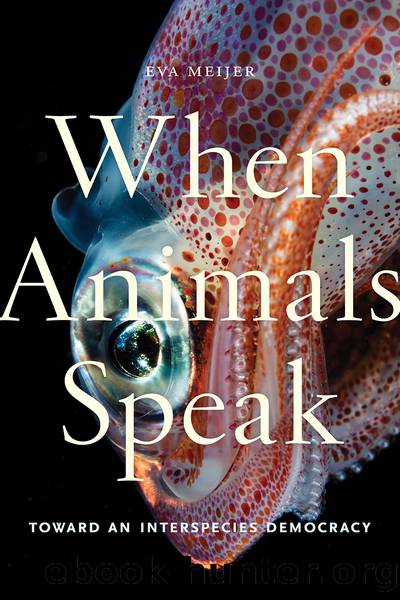When Animals Speak by Eva Meijer

Author:Eva Meijer [Meijer, Eva]
Language: eng
Format: epub
Tags: SOC026000 Social Science / Sociology / General
Publisher: NYU Press
Urban Animals
A final example of a situation in which current legislation and current social practices can function as a starting point for change can be found in the more-than-human practices aimed at greening the city (Hinchliffe and Whatmore 2006). A multitude of human/non-human animal relations exist in cities, but non-human animals do not often feature in urban theory or city planning. Jennifer Wolch (2010) argues that this is because urbanization is based on a view of progress that exploits nature on behalf of culture, and that rests on a problematic dichotomy between nature and culture (as well as, and relatedly, city-country and human-animal) (see also Wolch and Emel 1998). To address this exploitation, Wolch argues that we need to âre-enchantâ the city by acknowledging and fostering the presence there of non-human animals and nature, as well as by building new relationships with them; we need to invite the animals back in. Many non-human animals live in cities, but they are either seen as pests (Jerolmack 2008) or their presence is simply not acknowledged. Existing and future urban spaces, such as houses, gardens, parks, and roads, need to change because they are oppressive and unjust for humans and other animals. Reintegrating humans with animals and nature can âprovide urban dwellers with the local, situated, everyday knowledge of animal life required to grasp animal standpoints or ways of being in the world, to interact with them accordingly in particular contexts, and to motivate political action necessary to protect their autonomy as subjects and their life spacesâ (Wolch 2010, 226â27). Interacting with other animals in new ways will lead humans to see them differently, and vice versa.
Non-human animals are not completely absent from existing legislation and from urban practices, as the following example concerning nesting water birds in Amsterdam shows. In May 2016, the renovation of the Brandweerbrug, a bridge in Amsterdam, had to be halted because a pair of coots had built their nest in the reeds underneath the bridge. Nesting birds are protected by the behavioral code of the Flora- en faunawet (the Flora and Fauna Law) of Amsterdam, and procedures developed for this protection can lead to delayed building processes, or force humans to work around the nests. Nesting birds are also assisted by humans who live in the city. Because there are no natural spaces for the birds to nest, only walls, humans who live on or near the canals provide the birds with purpose-built nesting spaces so that they do not use boats or other human objects for nesting. These nests often have a sign saying âbroedplaatsâ (nesting place). Humans create these spaces in response to the presence and behavior of coots and other birds, and the coots use human litter to decorate their nests, often creating beautiful and colorful objects. When nests are disrupted, coots and humans both defend them. The efforts of citizens to provide coots and other birds with nesting spaces, and their formal counterpart in the behavioral code of the Flora- en faunawet, contribute to the greening of the city and take non-human animal agency into account in doing so.
Download
This site does not store any files on its server. We only index and link to content provided by other sites. Please contact the content providers to delete copyright contents if any and email us, we'll remove relevant links or contents immediately.
The Lonely City by Olivia Laing(4140)
Animal Frequency by Melissa Alvarez(3770)
All Creatures Great and Small by James Herriot(3540)
Walking by Henry David Thoreau(3245)
Exit West by Mohsin Hamid(3211)
Origin Story: A Big History of Everything by David Christian(3151)
COSMOS by Carl Sagan(2967)
How to Read Water: Clues and Patterns from Puddles to the Sea (Natural Navigation) by Tristan Gooley(2893)
Hedgerow by John Wright(2790)
The Inner Life of Animals by Peter Wohlleben(2780)
Origin Story by David Christian(2701)
How to Read Nature by Tristan Gooley(2675)
Project Animal Farm: An Accidental Journey into the Secret World of Farming and the Truth About Our Food by Sonia Faruqi(2673)
How to Do Nothing by Jenny Odell(2658)
Water by Ian Miller(2608)
A Forest Journey by John Perlin(2597)
The Plant Messiah by Carlos Magdalena(2468)
A Wilder Time by William E. Glassley(2373)
Forests: A Very Short Introduction by Jaboury Ghazoul(2347)
